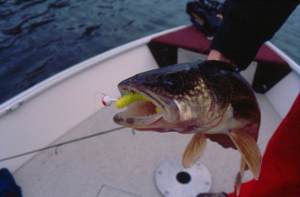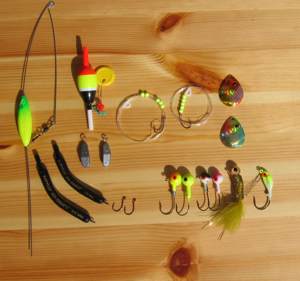|
Toughing Out the Turnover: Fall Walleye Tactics
By
Tim Allard
"Walleye put on a pretty aggressive feed in the fall. I'd say the
fishing is better than the spring bite," said Ted Takasaki,
professional walleye angler and president of Lindy - Legendary
Fishing Tackle, describing fishing after the fall turnover. If his
statement didn't convince you to fall fish, consider that the
absence of fair-weather anglers reduces boat traffic, and autumn
shorelines provide beautiful scenery. As water temperatures cool,
fish feed heavily to build up fat reserves for winter. Whether
you're a trophy hunter or a numbers angler, fall is one of the best
times to chase walleye.
Understanding Turnover:
In the summer a lake stratifies in to three main layers. The
upper layer consists of richly oxygenated, moving water and is
called the epilimion. Below this a thin, middle layer called the
metalimnion that contains the thermocline. In this middle layer, the
temperature and oxygen levels drop quickly in a short distance in
the water column. Finally, the last layer, the hypolimnion, consists
of cold water with poor oxygen levels; few fish can survive in this
area for very long. This lower layer of cold water is also the most
dense, with the warmer water of the other two layers (metalimnion
and epilimnion) sitting above it.
This division exists until the fall when the surface water cools.
Eventually the upper layer reaches a temperature and density similar
to the metalimnion and hypolimnion. The similar water temperature
and densities of the three layers, along with wind current, causes
the lake to mix, breaking the summer stratification and evenly
distributing water temperatures and oxygen levels through the entire
water column. With the lake now holding even oxygen levels, fish can
hold in deeper water - which is exactly what walleye do.
Location:
Walleye are structure oriented creatures and will never stray far
from food regardless of the season. In the early fall they still
concentrate on the edges of fast and slack water areas; key in on
rocky transition zones from shallow to deep water; and can
occasionally be found in healthy aquatic vegetation.
Takasaki explains that the perception that walleye are chaotically
scattered in a lake after turnover is a misrepresentation of their
patterns. "After turnover walleye start spreading throughout the
entire water column," taking advantage of oxygen rich deep water.
"30 to 50 feet is not deep when fall fishing," he adds. The walleye
guru recommends fishing: deep water points, humps, sharp drops and
inside turns. Yet, some walleye still roam the shallows at night to
feed. Finding structure that quickly transitions from shallow to
deep water is also important when searching for fall walleye.
Some anglers abandon lakes in the fall, traveling to rivers to avoid
dealing with turn over. When fishing rivers in autumn, Takasaki
suggests that walleye will still be found in slack water areas close
to fast moving water. He also explains they will move back to a dam
or the first obstruction in the river. They can also be found: above
or below rapids, in deep water holes, or close to current breaks.
Working the Structure:
After the turnover and into mid fall, walleye will be feeding
throughout the day stocking up for winter. Minnows are favourite
bait when targeting deep walleyes and, to Takasaki, "it's tough to
beat a red tailed chub wherever you go." Slow drifting bottom
bouncers or Lindy rigs tipped with minnows can produce on deep
flats. Jigs and slip bobbers can be effective to work these areas.
When using bobbers make sure you add enough weight so the majority
of the bobber rides below the surface. This way a walleye won't feel
the float's resistance when they grab the bait. For sharp breaks a
jig can be dynamite. Slowly lifting-and-pausing a jig tipped with a
four to six inch shiner will fool many fall walleye.

Keeping tackle simple works when fishing deep structure for walleye.
A jig and grub tipped with a minnow fooled this 'eye.
Before dawn and after dusk, try working shallow areas for walleye.
Some fish will stay deep but flats and shallows still containing
healthy aquatic vegetation will be prime feeding zones for hunting
marble-eyes. A tried and true method by many anglers is to slow
troll long, minnow-style baits on long lines (like Rapala's Husky
Jerk or Smithwick's Suspending Rogue) along the weedlines, breaks or
above weed tops. Some prefer a banana style bait with more wobble to
it (like Rapala's Tail Dancer or Cotton Cordell's Walleye Minnow) to
call in 'eyes. Also, don't be afraid to try trolling shallow running
baits over deep water, especially if you've marked baitfish at a
shallow depth on your sonar.
Gear and Safety:
Spring and summer walleye gear requirements remain the same for
fall fishing. Seven-foot medium action jigging rods will give you
better control over jigs and bobbers when fishing deep areas, as
well as more leverage for hauling in big fish. Look for a spinning
rod with a sensitive tip to pick up subtle hits. Superbraids will
enhance your ability to feel the faintest of takes. Medium to
medium-heavy baitcasting outfits are better suited for trolling
crankbaits. Walleye can strike hard during the fall, so spooling
trolling rods with monofilament will provide some stretch to absorb
hard hits. If using superbraid, ensure you set your drag loose to
prevent missing fish. A net is also crucial for landing fish and
keeping your hands dry.

Some fall walleye tackle (top left to right): a Northland's bottom
bouncer, walking sinkers, a slip bobber and bobber stops, walleye
harness rigs and spinner blades. Bottom left to right are: Lindy's
No-Snagg Sinkers, hooks for slip bobber minnow presentations, an
assortment of jigs including Lindy's Techni-Glo Fuzz-E-Grub and Veg-E-Jig.
Cold water fishing requires diligent safety precautions. I highly
recommend wearing a survival suit for this kind of fishing. These
suits are designed to trap your body heat should you fall in the
water, but also serve as a great outer layer for a full day of cold,
fall fishing. Proper boots, hats, gloves or mitts will also help
keep you warm, as will some coffee or hot chocolate stored in a
thermos. You'll also want to pack some sand and salt to handle icy
boat launches. An extra long tow line and rubber boots will help
keep your feet dry, as nothing ruins a trip faster than wet feet.
Fall walleyes fight hard, and your best bet to find them is to fish
deep structure. Aggressively feeding and stocking up their fat
reserves, almost all walleye are beautifully proportioned. It's a
perfect sight to catch a chunky, golden walleye against the backdrop
of fall foliage. Finally, as fall gives way to early winter, take
note of where you caught walleyes as these spots should be the first
you try once the hard water season begins!
|